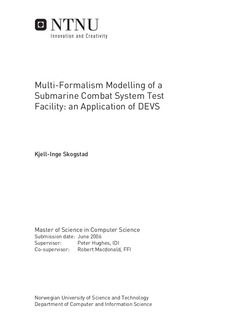Multi-Formalism Modelling of a Submarine Combat System Test Facility: an Application of DEVS
Abstract
This thesis aims at applying and exploring the DEVS-based theory for the purpose of gaining experiences and recommendations with regards to the usefulness of DEVS in the analysis of a submarine combat system and in establishing simulation credibility. In this regard, first a literature study of the DEVS-based literature is performed, before a case study is carried out, targeting a subset of the submarine combat system test bed under construction at Forsvarets forskningsinstitutt (FFI). In doing so, an architectural description of the subset based on DEVS is created and special requirements are discussed with regards to legacy components and technologies. Finally, the usefulness of DEVS is discussed based on experiences made during the first two tasks. Note that implementation and aspects with regards to an executable framework for the simulator is not covered. The findings of this study indicates that DEVS with its formal nature can be a valuable tool both with regards to analysis as well as in establishing credibility. Especially with regards to couplings and composability DEVS might prove helpful. The formal specifications and definitions can ensure that consistency is achieved. A formal experimental frame also ensures an unambiguous foundation for creating the simulation. With this in mind, an issue was discovered with regards to how far DEVS should go in covering aspects which can be argued to be part of the simulator within the abstract model. A solution involving the use of one or more lumped models is suggested, but need further study. Finally, the need for a proper tools and a graph notation is emphasised if DEVS is to be practical in complex simulations.
